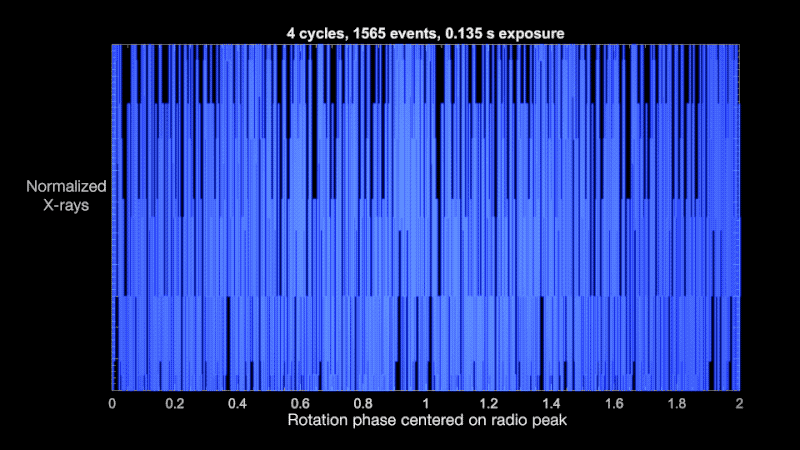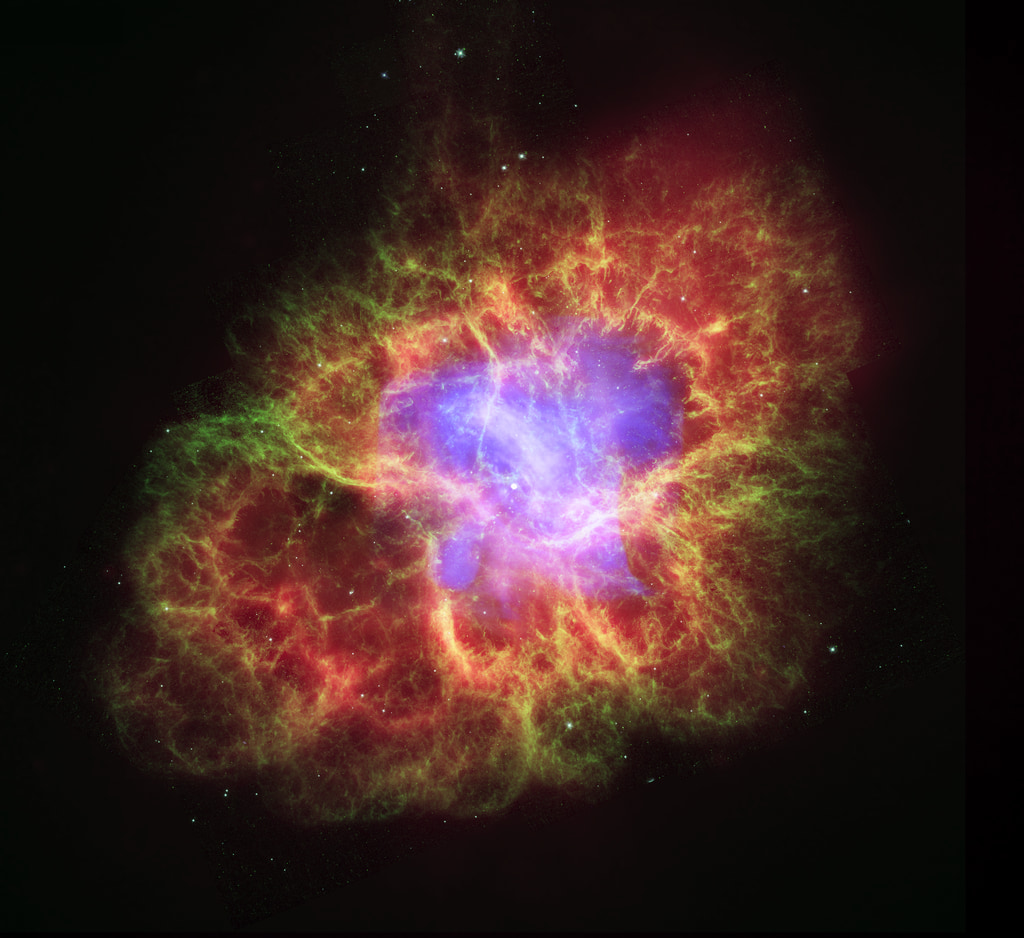Universe
ID: 13737
Scientists using data from NASA’s Neutron star Interior Composition Explorer (NICER) telescope on the International Space Station have discovered X-ray surges accompanying radio bursts from the pulsar in the Crab Nebula. The finding shows that these bursts, called giant radio pulses, release far more energy than previously suspected.
A pulsar is a type of rapidly spinning neutron star, the crushed, city-sized core of a star that exploded as a supernova. A young, isolated neutron star can spin dozens of times each second, and its whirling magnetic field powers beams of radio waves, visible light, X-rays, and gamma rays. If these beams sweep past Earth, astronomers observe clock-like pulses of emission and classify the object as a pulsar.
Located about 6,500 light-years away in the constellation Taurus, the Crab Nebula and its pulsar formed in a supernova explosion. The neutron star spins 30 times each second, and at X-ray and radio wavelengths it is among the brightest pulsars in the sky.
Out of more than 2,800 pulsars cataloged, the Crab pulsar is one of only a few that emit giant radio pulses, which occur sporadically and can be hundreds to thousands of times brighter than the regular pulses. And after decades of observations, only the Crab has been shown to enhance its giant radio pulses with emission from other parts of the spectrum.
Previously seen in visible light, these enhancements now have been detected in X-rays for the first time. Between August 2017 and August 2019, researchers used NICER to repeatedly observe the Crab pulsar in X-rays. While NICER was watching, the team also studied the object using at least one of two ground-based radio telescopes in Japan.
The team combined all of the X-ray data that coincided with giant radio pulses, revealing an X-ray boost of about 4% that occurred in synch with them. It’s remarkably similar to the 3% rise in visible light associated with the phenomenon, discovered in 2003. The researchers say that the total emitted energy associated with a giant pulse is dozens to hundreds of times higher than previously estimated from the radio and optical data alone.
The enhancements suggest that giant pulses are a manifestation of underlying processes that produce emission spanning the electromagnetic spectrum, from radio to X-rays. And because X-rays pack millions of times the punch of radio waves, even a modest increase represents a large energy contribution. The researchers conclude that the total emitted energy associated with a giant pulse is dozens to hundreds of times higher than previously estimated from the radio and optical data alone.


NASA’s NICER Finds X-ray Boosts in the Crab Pulsar’s Radio Bursts
A pulsar is a type of rapidly spinning neutron star, the crushed, city-sized core of a star that exploded as a supernova. A young, isolated neutron star can spin dozens of times each second, and its whirling magnetic field powers beams of radio waves, visible light, X-rays, and gamma rays. If these beams sweep past Earth, astronomers observe clock-like pulses of emission and classify the object as a pulsar.
Located about 6,500 light-years away in the constellation Taurus, the Crab Nebula and its pulsar formed in a supernova explosion. The neutron star spins 30 times each second, and at X-ray and radio wavelengths it is among the brightest pulsars in the sky.
Out of more than 2,800 pulsars cataloged, the Crab pulsar is one of only a few that emit giant radio pulses, which occur sporadically and can be hundreds to thousands of times brighter than the regular pulses. And after decades of observations, only the Crab has been shown to enhance its giant radio pulses with emission from other parts of the spectrum.
Previously seen in visible light, these enhancements now have been detected in X-rays for the first time. Between August 2017 and August 2019, researchers used NICER to repeatedly observe the Crab pulsar in X-rays. While NICER was watching, the team also studied the object using at least one of two ground-based radio telescopes in Japan.
The team combined all of the X-ray data that coincided with giant radio pulses, revealing an X-ray boost of about 4% that occurred in synch with them. It’s remarkably similar to the 3% rise in visible light associated with the phenomenon, discovered in 2003. The researchers say that the total emitted energy associated with a giant pulse is dozens to hundreds of times higher than previously estimated from the radio and optical data alone.
The enhancements suggest that giant pulses are a manifestation of underlying processes that produce emission spanning the electromagnetic spectrum, from radio to X-rays. And because X-rays pack millions of times the punch of radio waves, even a modest increase represents a large energy contribution. The researchers conclude that the total emitted energy associated with a giant pulse is dozens to hundreds of times higher than previously estimated from the radio and optical data alone.


Related
Credits
Scott Wiessinger (USRA): Producer
Francis Reddy (University of Maryland College Park): Science Writer
Zaven Arzoumanian (NASA/GSFC): Scientist
Scott Wiessinger (USRA): Narrator
Francis Reddy (University of Maryland College Park): Science Writer
Zaven Arzoumanian (NASA/GSFC): Scientist
Scott Wiessinger (USRA): Narrator
Please give credit for this item to:
NASA's Goddard Space Flight Center
NASA's Goddard Space Flight Center
Short URL to share this page:
https://svs.gsfc.nasa.gov/13737
Mission:
Neutron star Interior Composition Explorer (NICER)
This item is part of these series:
Narrated Movies
Astrophysics Features
Keywords:
SVS >> HDTV
SVS >> Music
SVS >> Neutron Star
SVS >> X-ray
GCMD >> Earth Science >> Spectral/Engineering >> Radio Wave
SVS >> Astrophysics
SVS >> Pulsar
SVS >> Edited Feature
SVS >> Space
DLESE >> Narrated
SVS >> Star
NASA Science >> Universe
SVS >> NICER
GCMD keywords can be found on the Internet with the following citation: Olsen, L.M., G. Major, K. Shein, J. Scialdone, S. Ritz, T. Stevens, M. Morahan, A. Aleman, R. Vogel, S. Leicester, H. Weir, M. Meaux, S. Grebas, C.Solomon, M. Holland, T. Northcutt, R. A. Restrepo, R. Bilodeau, 2013. NASA/Global Change Master Directory (GCMD) Earth Science Keywords. Version 8.0.0.0.0
https://svs.gsfc.nasa.gov/13737
Mission:
Neutron star Interior Composition Explorer (NICER)
This item is part of these series:
Narrated Movies
Astrophysics Features
Keywords:
SVS >> HDTV
SVS >> Music
SVS >> Neutron Star
SVS >> X-ray
GCMD >> Earth Science >> Spectral/Engineering >> Radio Wave
SVS >> Astrophysics
SVS >> Pulsar
SVS >> Edited Feature
SVS >> Space
DLESE >> Narrated
SVS >> Star
NASA Science >> Universe
SVS >> NICER
GCMD keywords can be found on the Internet with the following citation: Olsen, L.M., G. Major, K. Shein, J. Scialdone, S. Ritz, T. Stevens, M. Morahan, A. Aleman, R. Vogel, S. Leicester, H. Weir, M. Meaux, S. Grebas, C.Solomon, M. Holland, T. Northcutt, R. A. Restrepo, R. Bilodeau, 2013. NASA/Global Change Master Directory (GCMD) Earth Science Keywords. Version 8.0.0.0.0












